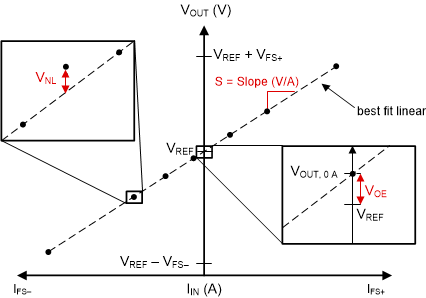SBOSAF6 June 2024 TMCS1127
PRODUCTION DATA
- 1
- 1 Features
- 2 Applications
- 3 Description
- 4 Device Comparison
- 5 Pin Configuration and Functions
- 6 Specifications
- 7 Parameter Measurement Information
- 8 Detailed Description
- 9 Application and Implementation
- 10Device and Documentation Support
- 11Revision History
- 12Mechanical, Packaging, and Orderable Information
7.1.1 Sensitivity Error
Sensitivity is the proportional change in the sensor output voltage due to a change in the input conductor current. This sensitivity is the slope of the first-order transfer function of the sensor (see Figure 7-1). The sensitivity of the TMCS1127 is tested and calibrated at the factory for high accuracy.
 Figure 7-1 Sensitivity,
Offset, and Nonlinearity Error
Figure 7-1 Sensitivity,
Offset, and Nonlinearity ErrorSensitivity error eS is the deviation from ideal sensitivity and is defined in Equation 2 as the variation of the best-fit measured sensitivity from the ideal sensitivity.
where
- eS is the sensitivity error.
- Sfit is the best fit sensitivity.
- SIdeal is the ideal sensitivity.
Sensitivity thermal drift Sdrift,therm is the change in sensitivity with temperature and is reported in ppm/°C. To calculate sensitivity error at any given temperature T use Equation 3 to multiply the sensitivity thermal drift by the change in temperature from 25°C and add that value to the sensitivity error at 25°C.
where
- Sdrift,therm is the sensitivity drift over temperature in ppm/°C.
- ΔT is the change in device temperature from 25°C.
Sensitivity lifetime drift Sdrift,life is the change in sensitivity due to operational and environmental stresses over the entire lifetime of the device, and is reported as a worst-case percentage change in sensitivity over lifetime at 25°C.